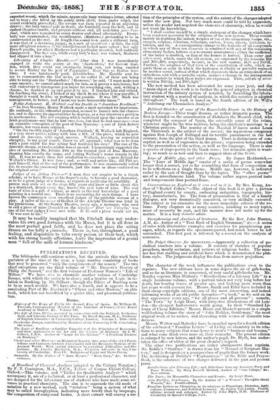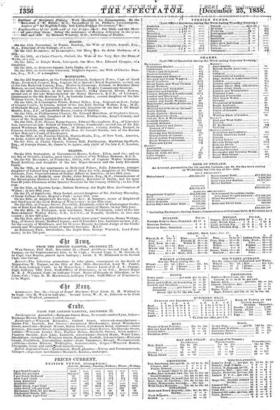PUBLICATIONS RECEIVED.
The bibliopoles still continue active, but the arrivals this week have partaken of the time of the year, a large number consisting of books that may be presented "with the compliments of the season." The two chief exceptions are the third volume of " Mr. Prescott's History of Philip the Second," and the first volume of Professor Masson's "Life of Milton." We have also to chronicle another voltune of Cambridge Essays, with which the series is to close; and a treatise on Logic in re- lation to Banking, by Mr. Gilbert ; though the Ethics of Banking seem to be as much needed. We have also a fourth, and it appears to be a concluding Part of Mr. Hardwick's "Christ and other Masters," an able book, which has not benefitted by a quaint title, and piecemeal publica- tion.
Booxs.
History of the Reign of Philip the Second, King of Spain. By William H. Prescott, Corresponding Member of the Institute of France, of the Royal Academy at Madrid, &e. Volume III.
The Life of John Hilton, narrated in connection with the Political, Ecclesias- tical, and Literary History of IIis Time. By David Masson, M.A., Professor of English Literature in University College, London. Volume I. 1608-1639.
Cambridge Essays, contributed by Members of the University 1e58. Concluding the series.
The Logic of Banking : a familiar Exposithm of the Principles of Reasoning, and their application to the Art and the Science of Banking. By J. W. Gilbert, I.R.S. Author of "Logic for the Million," •• A Practical Treatise on Banking."
Christ and other Hasters: an Historical Inquiry into some of the chief Paral- lelisms and Contrasts between Christianity and the Religious Systems of the Ancient World. With special reference to prevailing Difficulties and Ob- jections. By Charles Hardwick, M.A., Christian Advocate in the Uni- versity of Cambridge. Part I Religions of Egypt and Mcdo-Persia. Onwards. By the Author of "Anna Dysart," "Rosa Grey," tke. In three volumes.
A Handbook of Chemical Analysis (adapted to the Unitary Notation.) By F. T. Conington, M.A., F.C.S., Fellow of Corpus Christi College, Oxforcl.—This volume, and "Tables for Qualitative Analysis" which accompany it, are of a technical, or at least a professional character, and are designed for the laboratory use of students who have made some ad- vance in practical chemistry. The aim is to supersede the old mode of notation by a new method, each "notation" being a system of what may be ogled hieroglyphics, indicating more briefly than by language, the composition of compound bodies. A short extract will convey a no- tion of the principles of the system, and the extent of the changes adapted under the new plan. Not very much more could be told by expansion, unless the reader had acquired the elements of chemistry, when Ina would not want the knowledge, " I shall confine myself to a simple statement of the changes which have been rendered necessary by the adoption of the new system. These consist mainly in doubling the atomic weights of ten of the efenientary oxygen, sulphur, selenium, tellurian, carbon' boron, silicon, tantalum, ti- tanium, and tin. A corresponding change in the formulte of all compounds in which any of these ten elements is combined with any of the remaining elementary bodies, follows as a necessary consequence; either eoelnt of the latter is doubled, or that of the former is haired. Thus water sPA nitric acid, which, under the old system are expressed by the formula" HO and NO5,110,, respectively, become, in 'the new system, 1120 and NOSH. Further, the adoption of that view of the constitution of salts, which re- gards them as acids in which the hydrogen is wholly or partially replaced by another metal, instead of that which represents them as compounds of an anhydrous acid with a metallic oxide, induces a change in the arrangement of the symbols by which these bodies are expressed. Thus, nitrate ofsilver is written NO3,1g, not NO3,Ag0."
The new method has been advocated for some years 'past, and the "main object of this work is to further the general adoption in cheraied instruction of the unitary system of notation, by furnishing the labora- tory student with a manual of' analysis, in which this notation is adopted throughout." The book is based on the fourth edition of Dr. Will's " Anleitung zur Chemischen Analyse."
Political SA-etches of some of the Remarkable Events in the History of Modern Ettrope.—Three tragic dramas, or rather dramatic poems. The first is founded on the assassination of Abdulazis the Moorish chief, who completed the conquest of Spain, the ostensible cause of the Crime, whatever might be the true motives, being the chieftain's marriage to a Christian princess. The murder of the Marshal D'Ancre under Louis the Thirteenth is the subject of the second; the mysterious conspiracy against Don Joseph of Portugal and its terrible punishment in the last century, form the plot of the third drama. There is distinctness of con- ception as well as of expression in the pieces • expression being extended to the presentation of the action, as well as the language. There is also a species of stage-poetry in the blank verse ; but dramatic spirit is want- ing; so much so as now and then to suggest ideas of the Critic.
Lays of Middle Age, and other Poems. By Tames Hedderrick.— The Lays of Middle Age" consist of a series of poems somewhat longer than a sonnet, yet so far resembling that form of composition as to be reflections on a single theme. Middle age, however, is indicated rather by the cast of thought than by the topics. The "other poems" are of a miscellaneous kind. The volume rather argues poetical taste and temperament than poetical flame.
Conversations on England as it was and as it is. By Mrs. Kemp, Au- thor of "Rachel Cohen."—The object of this book is to give a picture of England county by county, embracing antiquities, topography, his- tory, manufactures, &c. The form of presentation is that of a family dialogue, not very dramatically conceived, or very skilfully executed. The subject is too extensive for the more immediate scheme of the vo- lume. Forty chapters on as many counties, handling so many topics, must of necessity be curt, and the manner does not make up for the matter. It is a very didactic affair.
Paraphrasing and Analysis of Sentences. By the Rev. John Hunter, A.M. &c. Author of a "Text Book of English Grammar," &c.—A series of rules with illustrative examples and exercises for paraphrasing pas- sages, which, as regards the specimens quoted, had much better be left untouched. This first part is followed by a second on the analysis of sentences.
The Pulpit Observer for enceerxrin—Apparently a collection of pe- riodical numbers into a volume. It consists of sketches of popular preachers, mostly sectarian, and reviews of religious books. The man- ner has that startling and artificial force which is denominated the plat- form style. The judgments display freedom from narrow prejudices.
The character of the week influences the publications even to the reprints. The new editions have in some degree the air of gift-books, and so far as literature is concerned, of very useful gift-books too. Mr. Bentley reprints Miss Mitford's "Recollections of a Literary Life" in a single handsome volume, with a portrait taken not very long before her death, but bearing traces of greater age, and looking more worn than her years would account for. Messrs. Smith and Elder have included in their cheap copyright editions, one of the most interesting, and indeed informing works of an old public favourite—" a book," as we said on its first appearance years ago, "for all places and all persons" ; namely, "The Town" by Leigh Hunt, with forty-five illustrations of old Lon- don—the cheapest half-crown's worth going. In their "Standard Li- brary of Cheap Editions," Messrs. Hurst and Blackett present in a single well-looking volume the story of "John Halifax, Gentleman," the most original work of its author, and abounding with scenes of domestic ten. derness.
Messrs. Walton and llaberley have been called upon for a fourth edition of the celebrated "Familiar Letters" of Liebig on chemistry in its rela- tions to many subjects that come home to men's "business and bosoms," and what some think even more of, their stomachs. The present edition is enlarged by new letters, and the author's pupil, Dr. Blyth, has under- taken the office of editor at the great chemist's request. The other two publications are rather abridgments than reprints. Mr. Riddle's " Outlines " is drawn from his "Manual of Scripture His- tory," and is designed for a younger class of pupils than the former work. The Archbishop of Dublin's " Explanations " of the Bible and Prayer- Book, is the substance of two charges delivered in the past and present years. Recollertions of a Literary Life ; and Selections from my favourite Poets and Probe Writers. By Mary Russell Mitford, Author of "Our Village," &o. New edition.
The Town ; its Memorable CharaCters and Events. By Leigh Hunt.
John Halifax, Gentlenian, By the Author of "A Woman's Thoughts about Women," &c. Fourth edition. Familiar Letters on Chemistry, in its relations to Physiology, Dietetics, Agri. culture, Commerce, and Political Economy. Br Justus Von Liebig. Fourth edition, revised and enlarged, Edited by Jan Blyth, M.D. Professor of Chemistry in Queen's College, Cork. Off_TOW. of " ritif forAinatizhaidinom.,My the Lii °M.iVeft.ft I'1H1 R186Ieof Si. Philip's; 1Leckliampton. Author "Mid IffirEir&ish Dietionary,e. ' ' • 10 .rapKtrutiebsts the, Bib& an of the Prefier- ok tlidfraaly an 114 !Mode selustif)pltividing Being the enbitance 'of arges delivered in the years -t,..!e;1867andt18.18P By Itieharid!Whatel, D.a., Arehbishop of Dublin.



























 Previous page
Previous page